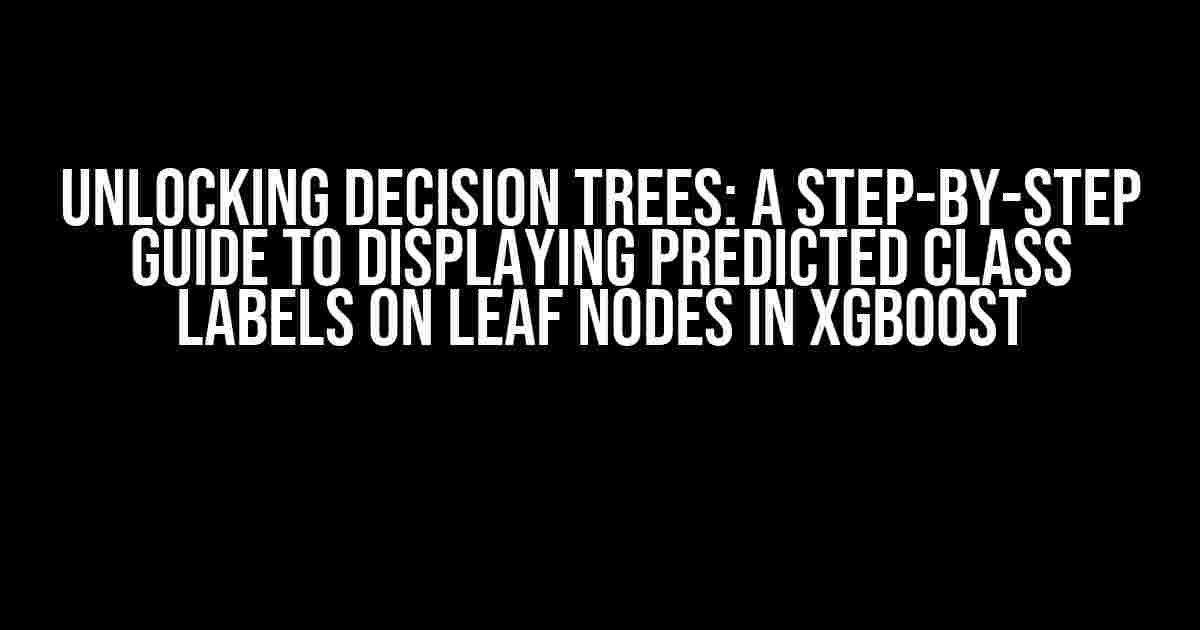Welcome to the world of decision trees, where the thrill of predictive modeling meets the complexity of data analysis! In this comprehensive guide, we’ll embark on a quest to conquer the often-overlooked yet crucial aspect of XGBoost decision trees: displaying predicted class labels on leaf nodes.
Why Do I Need to Display Predicted Class Labels on Leaf Nodes?
Before we dive into the how, let’s explore the why. Displaying predicted class labels on leaf nodes is essential for several reasons:
- Interpretability**: By visualizing the predicted class labels, you gain a deeper understanding of how your model is making predictions, allowing you to identify patterns and relationships in your data.
- Model Evaluation**: Leaf node class labels provide a clear indication of your model’s performance, enabling you to assess its accuracy and identify areas for improvement.
- Feature Importance**: By examining the class labels on leaf nodes, you can deduce which features are most influential in the prediction process, helping you to optimize feature engineering.
Prerequisites and Setup
Before we begin, ensure you have the following installed:
- XGBoost (pip install xgboost)
- Python 3.x
- A compatible IDE or text editor
Let’s set up a sample dataset for demonstration purposes. We’ll use the famous Iris dataset, which contains 150 samples from three species of Iris flowers:
from sklearn.datasets import load_iris from sklearn.model_selection import train_test_split iris = load_iris() X = iris.data y = iris.target X_train, X_test, y_train, y_test = train_test_split(X, y, test_size=0.2, random_state=42)
Step 1: Train an XGBoost Decision Tree Model
First, we’ll train an XGBoost decision tree model on our dataset:
import xgboost as xgb xgb_model = xgb.XGBClassifier(max_depth=5, learning_rate=0.1, n_estimators=100) xgb_model.fit(X_train, y_train)
Step 2: Plot the Decision Tree
To visualize the decision tree, we’ll use the xgb.plot_tree() function:
import matplotlib.pyplot as plt xgb.plot_tree(xgb_model, num_trees=0, rankdir='LR') plt.show()
This will generate a decision tree plot with the feature names on the internal nodes and the class labels on the leaf nodes. However, the class labels might not be explicitly displayed. Let’s fix that!
Step 3: Extract and Display Predicted Class Labels on Leaf Nodes
We’ll use the xgb.plot_tree() function with some customizations to display the predicted class labels on leaf nodes:
def plot_tree_with_labels(model, num_trees=0, rankdir='LR'):
ax = xgb.plot_tree(model, num_trees=num_trees, rankdir=rankdir)
labels = model.get_booster().get_fscore()
for axe in ax:
for node in axe.get_children():
if node.get_children() == []:
node_text = node.get_text().split('\n')[0]
class_label = labels.get(node_text, 'Unknown')
node.set_text(node_text + '\nPredicted Label: ' + str(class_label))
plt.show()
plot_tree_with_labels(xgb_model, num_trees=0, rankdir='LR')
Voilà! Our decision tree plot now displays the predicted class labels on the leaf nodes:
Step 4: Interpret and Refine Your Model
Now that you have a visual representation of your model’s decision-making process, you can:
- Identify the most important features contributing to the predictions.
- Analyze the class distribution on leaf nodes to detect biases or areas for improvement.
- Refine your model by tuning hyperparameters, experimenting with different feature engineering techniques, or exploring ensemble methods.
Conclusion
Displaying predicted class labels on leaf nodes in XGBoost decision trees is a crucial step in model interpretation and evaluation. By following this step-by-step guide, you’ve unlocked the power of visualization to gain deeper insights into your model’s decision-making process.
Remember, the key to mastering decision trees lies in understanding the intricacies of your model. By harnessing the predictive capabilities of XGBoost and the explanatory power of visualization, you’ll be well on your way to becoming a decision tree virtuoso!
Happy modeling, and don’t forget to explore the wonderful world of decision trees!
Keywords: XGBoost, decision trees, predicted class labels, leaf nodes, model interpretation, visualization, machine learning
Frequently Asked Question
Are you stuck on how to display predicted class labels on the leaf nodes of an XGBoost decision tree? Don’t worry, we’ve got you covered!
How can I get the predicted class labels from an XGBoost model?
You can use the `predict` method of the XGBoost model to get the predicted class labels. For example, if you have an XGBoost model named `xgb_model` and a test dataset `X_test`, you can get the predicted class labels using `xgb_model.predict(X_test)`. This will return an array of predicted class labels for each sample in the test dataset.
How do I visualize an XGBoost decision tree with predicted class labels?
You can use the `plot_tree` function from the `xgboost` library to visualize an XGBoost decision tree. To display the predicted class labels on the leaf nodes, you need to pass the `label_style` parameter and set it to `’gain’`. For example, `xgb.plot_tree(xgb_model, num_trees=0, rankdir=’LR’, label_style=’gain’)`. This will create a plot of the decision tree with the predicted class labels displayed on the leaf nodes.
Can I customize the appearance of the predicted class labels in the decision tree plot?
Yes, you can customize the appearance of the predicted class labels in the decision tree plot using various options available in the `plot_tree` function. For example, you can change the font size, color, and style of the labels using the `font_size`, `font_family`, and `color` parameters. You can also use the `orientation` parameter to rotate the labels or use the `label_offset` parameter to adjust the position of the labels.
How do I save the decision tree plot with predicted class labels to a file?
You can save the decision tree plot with predicted class labels to a file using the `matplotlib.pyplot` library. After creating the plot using `xgb.plot_tree`, you can use the `savefig` function to save the plot to a file. For example, `plt.savefig(‘decision_tree.png’, dpi=300)`. This will save the plot to a file named `decision_tree.png` with a resolution of 300 dpi.
Can I display additional information on the leaf nodes of the decision tree?
Yes, you can display additional information on the leaf nodes of the decision tree using the `node_info` parameter of the `plot_tree` function. For example, you can display the number of samples or the class distribution at each leaf node. You can also use custom node information by passing a dictionary with node IDs as keys and the desired information as values.
